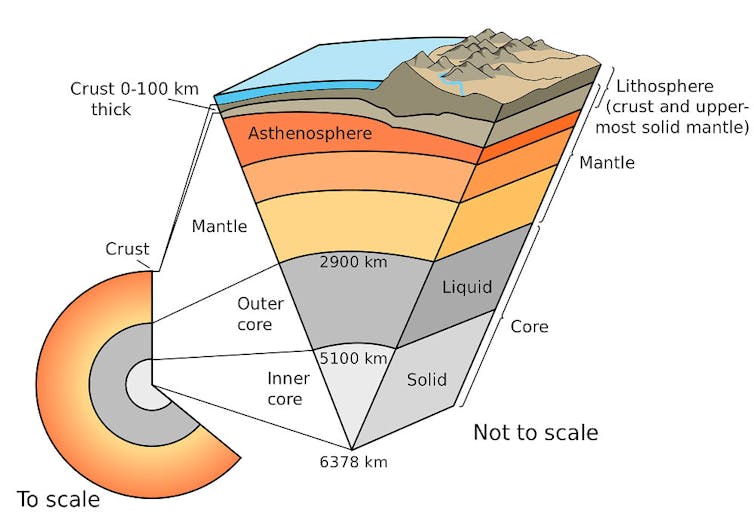Typhoon Shanshan barrels up Japan as five reported dead
The typhoon, one of the strongest to hit Japan in decades, had weakened by early morning, though gusts were still reaching 126 kilometres (78 miles) per hour.
Oita (Japan) (AFP) – Typhoon Shanshan slowly barrelled up the Japanese archipelago Friday, dumping torrential rains and causing transport havoc as its reported death toll reached five.
Issued on: 30/08/2024

A car drives through a flooded street in Yufu city of Oita prefecture © Yuichi YAMAZAKI / AFP
The typhoon, one of the strongest to hit Japan in decades, had weakened by early morning, though gusts were still reaching 126 kilometres (78 miles) per hour.
Even before making landfall on the island of Kyushu, a landslide caused by the heavy rains preceding it killed three members of the same family late Tuesday in Aichi prefecture, around 1,000 kilometres (600 miles) away.

A bus is seen submerged in floodwaters in Yufu city of Oita prefecture © Yuichi YAMAZAKI / AFP
Two more people were reported to have died including a man last seen on a small boat in Kyushu and another whose two-storey home partially collapsed in Tokushima prefecture on the neighbouring island of Shikoku.
At least 81 others have been injured, including many hurt by broken glass after the typhoon smashed windows and ripped tiles off roofs when it slammed into Kyushu on Thursday with gusts up to 252 kph.
Two more people were reported to have died including a man last seen on a small boat in Kyushu and another whose two-storey home partially collapsed in Tokushima prefecture on the neighbouring island of Shikoku.
At least 81 others have been injured, including many hurt by broken glass after the typhoon smashed windows and ripped tiles off roofs when it slammed into Kyushu on Thursday with gusts up to 252 kph.

A car overturned by strong winds from Typhoon Shanshan in Miyazaki © Handout / Miyazaki City Hall/AFP
Authorities issued their highest alert in several areas, with more than five million people advised to evacuate, although it was unclear how many did.
As far away as the town of Ninomiya near Tokyo, authorities urged residents to take "immediate measures" to secure safety such as moving to higher floors after a local river flooded.
Some parts of Kyushu saw record rains for August, with the town of Misato recording a staggering 791.5 millimetres (31 inches) in 48 hours, the Japan Meteorological Agency said.
Authorities issued their highest alert in several areas, with more than five million people advised to evacuate, although it was unclear how many did.
As far away as the town of Ninomiya near Tokyo, authorities urged residents to take "immediate measures" to secure safety such as moving to higher floors after a local river flooded.
Some parts of Kyushu saw record rains for August, with the town of Misato recording a staggering 791.5 millimetres (31 inches) in 48 hours, the Japan Meteorological Agency said.

A worker in Japan removes debris blown away by strong winds caused by Typhoon Shanshan on Thursday © STR / JIJI Press/AFP
Power cuts hit more than 250,000 Kyushu households but the utility operator said Friday that only 6,500 were still without electricity as engineers repaired damaged transmission lines.
Overnight, many motorways were fully or partially closed in Kyushu, as well as others further afield, media reports said.
Shinkansen bullet trains remained suspended in Kyushu and were also halted on the major route between Tokyo and Osaka, with operators warning of disruptions elsewhere.
Japan Airlines and ANA had already announced the cancellation of more than 600 flights between them for Friday, having scrapped a similar number the previous day, affecting almost 50,000 passengers.
Auto giant Toyota suspended production at all 14 of its factories in Japan.
Nissan and Honda also halted operations at their Kyushu plants, as did chipmakers including Tokyo Electron, reports said.
Shanshan comes in the wake of Typhoon Ampil, which dumped heavy rain that disrupted hundreds of flights and trains this month but caused only minor injuries and damage.
Another released by World Weather Attribution (WWA) on Thursday said that climate change turbocharged Typhoon Gaemi, which killed dozens of people across the Philippines, Taiwan and China this year.
© 2024 AFP
Power cuts hit more than 250,000 Kyushu households but the utility operator said Friday that only 6,500 were still without electricity as engineers repaired damaged transmission lines.
Overnight, many motorways were fully or partially closed in Kyushu, as well as others further afield, media reports said.
Shinkansen bullet trains remained suspended in Kyushu and were also halted on the major route between Tokyo and Osaka, with operators warning of disruptions elsewhere.
Japan Airlines and ANA had already announced the cancellation of more than 600 flights between them for Friday, having scrapped a similar number the previous day, affecting almost 50,000 passengers.
Auto giant Toyota suspended production at all 14 of its factories in Japan.
Nissan and Honda also halted operations at their Kyushu plants, as did chipmakers including Tokyo Electron, reports said.
Shanshan comes in the wake of Typhoon Ampil, which dumped heavy rain that disrupted hundreds of flights and trains this month but caused only minor injuries and damage.
Another released by World Weather Attribution (WWA) on Thursday said that climate change turbocharged Typhoon Gaemi, which killed dozens of people across the Philippines, Taiwan and China this year.
© 2024 AFP
Typhoon Shanshan has killed at least five people and injured dozens since making landfall in Japan on Thursday, according to the latest report given on Friday. Floods and landslides are now feared by the authorities.
Issued on: 30/08/2024 -

A vehicle drives along a flooded road next to the Sakai River which overflowed due to the effects of Typhoon Shanshan, Japan, August 29,2024. © AFP - STR
By: NEWS WIRES
Typhoon Shanshan slowly barrelled up the Japanese archipelago Friday, dumping torrential rains and causing transport havoc as its reported death toll reached five.
The typhoon, one of the strongest to hit Japan in decades, had weakened by early morning, though gusts were still reaching 126 kilometres (78 miles) per hour.
Even before making landfall on the island of Kyushu, a landslide caused by the heavy rains preceding it killed three members of the same family late Tuesday in Aichi prefecture, around 1,000 kilometres (600 miles) away.
Two more people were reported to have died including a man last seen on a small boat in Kyushu and another whose two-storey home partially collapsed in Tokushima prefecture on the neighbouring island of Shikoku.
At least 81 others have been injured, including many hurt by broken glass after the typhoon smashed windows and ripped tiles off roofs when it slammed into Kyushu on Thursday with gusts up to 252 kph.
Authorities issued their highest alert in several areas, with more than five million people advised to evacuate, although it was unclear how many did.
As far away as the town of Ninomiya near Tokyo, authorities urged residents to take "immediate measures" to secure safety such as moving to higher floors after a local river flooded.
Some parts of Kyushu saw record rains for August, with the town of Misato recording a staggering 791.5 millimetres (31 inches) in 48 hours, the Japan Meteorological Agency said.
Power cuts hit more than 250,000 Kyushu households but the utility operator said Friday that only 6,500 were still without electricity as engineers repaired damaged transmission lines.
Overnight, many motorways were fully or partially closed in Kyushu, as well as others further afield, media reports said.
Shinkansen bullet trains remained suspended in Kyushu and were also halted on the major route between Tokyo and Osaka, with operators warning of disruptions elsewhere.
Japan Airlines and ANA had already announced the cancellation of more than 600 flights between them for Friday, having scrapped a similar number the previous day, affecting almost 50,000 passengers.
Auto giant Toyota suspended production at all 14 of its factories in Japan.
Nissan and Honda also halted operations at their Kyushu plants, as did chipmakers including Tokyo Electron, reports said.
Shanshan comes in the wake of Typhoon Ampil, which dumped heavy rain that disrupted hundreds of flights and trains this month but caused only minor injuries and damage.
Typhoons in the region have been forming closer to coastlines, intensifying more rapidly and lasting longer over land due to climate change, according to a study released last month.
Another released by World Weather Attribution (WWA) on Thursday said that climate change turbocharged Typhoon Gaemi, which killed dozens of people across the Philippines, Taiwan and China this year.
(AFP)
Typhoon Shanshan slowly barrelled up the Japanese archipelago Friday, dumping torrential rains and causing transport havoc as its reported death toll reached five.
The typhoon, one of the strongest to hit Japan in decades, had weakened by early morning, though gusts were still reaching 126 kilometres (78 miles) per hour.
Even before making landfall on the island of Kyushu, a landslide caused by the heavy rains preceding it killed three members of the same family late Tuesday in Aichi prefecture, around 1,000 kilometres (600 miles) away.
Two more people were reported to have died including a man last seen on a small boat in Kyushu and another whose two-storey home partially collapsed in Tokushima prefecture on the neighbouring island of Shikoku.
At least 81 others have been injured, including many hurt by broken glass after the typhoon smashed windows and ripped tiles off roofs when it slammed into Kyushu on Thursday with gusts up to 252 kph.
Authorities issued their highest alert in several areas, with more than five million people advised to evacuate, although it was unclear how many did.
As far away as the town of Ninomiya near Tokyo, authorities urged residents to take "immediate measures" to secure safety such as moving to higher floors after a local river flooded.
Some parts of Kyushu saw record rains for August, with the town of Misato recording a staggering 791.5 millimetres (31 inches) in 48 hours, the Japan Meteorological Agency said.
Power cuts hit more than 250,000 Kyushu households but the utility operator said Friday that only 6,500 were still without electricity as engineers repaired damaged transmission lines.
Overnight, many motorways were fully or partially closed in Kyushu, as well as others further afield, media reports said.
Shinkansen bullet trains remained suspended in Kyushu and were also halted on the major route between Tokyo and Osaka, with operators warning of disruptions elsewhere.
Japan Airlines and ANA had already announced the cancellation of more than 600 flights between them for Friday, having scrapped a similar number the previous day, affecting almost 50,000 passengers.
Auto giant Toyota suspended production at all 14 of its factories in Japan.
Nissan and Honda also halted operations at their Kyushu plants, as did chipmakers including Tokyo Electron, reports said.
Shanshan comes in the wake of Typhoon Ampil, which dumped heavy rain that disrupted hundreds of flights and trains this month but caused only minor injuries and damage.
Typhoons in the region have been forming closer to coastlines, intensifying more rapidly and lasting longer over land due to climate change, according to a study released last month.
Another released by World Weather Attribution (WWA) on Thursday said that climate change turbocharged Typhoon Gaemi, which killed dozens of people across the Philippines, Taiwan and China this year.
(AFP)
Powerful Typhoon Shanshan slams into southern Japan
By AFP
August 28, 2024

A Japan Meteorological Agency satellite photo shows typhoon Shanshan moving closer to Kyushu island - Copyright Japan Meteorological Agency/AFP Handout
Hiroshi HIYAMA
Typhoon Shanshan slammed into Japan’s main southern island of Kyushu early Thursday, with authorities advising thousands of people to evacuate and issuing the highest warning level for wind and storm surges.
The weather office said that Japan’s most powerful typhoon this year made landfall at around 8:00 am (2300 GMT Wednesday) packing gusts of up to 252 kilometres (157 miles) per hour.
Kyushu’s utility operator said that 254,610 houses were already without power.
“Special warnings of violent storms, high waves and high tides are being issued to the Kagoshima region (of Kyuhsu),” the Japan Meteorological Office said.
“Please exercise maximum vigilance against violent storms, high waves and high tides in Kagoshima, as well as landslides, flooding in low-lying areas and overflowing rivers in southern Kyushu,” it said.
“Please also be advised that the risk of a disaster due to heavy rain can rapidly escalate in western Japan as Friday approaches.”
Heavy rain brought by Shanshan has been lashing large parts of Japan since Tuesday.
Three members of a family died after a landslide buried a house in Gamagori, a city in central Aichi prefecture, Japan’s Kyodo news agency reported early Thursday, citing local government officials.
The deceased included a couple in their 70s as well as a son in his 30s, while two adult daughters in their 40s survived with injuries, Kyodo reported.
For southern Kyushu, the JMA predicted an enormous 1,100 millimetres (43 inches) of precipitation in the 48 hours to Friday morning.
Video on public broadcaster NHK TV showed roof tiles being blown off houses, broken windows and felled trees.
“Our carport roof was blown away in its entirety. I wasn’t at home when it happened, but my kids say they felt the shaking so strong they thought an earthquake happened,” a local resident in Miyazaki told NHK.
“I was surprised. It was completely beyond our imagination,” she said.
Auto giant Toyota has suspended production at all 14 of its factories in Japan.
Japan Airlines cancelled 172 domestic flights and six international flights scheduled for Wednesday and Thursday, while ANA nixed 219 domestic flights and four international ones on Wednesday, Thursday and Friday.
The cancellations affected around 25,000 people.
Kyushu Railway said it would suspend some Shinkansen bullet train services between Kumamoto and Kagoshima Chuo from Wednesday night and warned of further possible disruption.
Trains between Tokyo and Fukuoka, the most populous city on Kyushu, may also be cancelled depending on weather conditions this week, other operators said.
Shanshan comes in the wake of Typhoon Ampil, which disrupted hundreds of flights and trains this month.
Despite dumping heavy rain, it caused only minor injuries and damage.
Ampil came days after Tropical Storm Maria brought record rains to northern areas.
Typhoons in the region have been forming closer to coastlines, intensifying more rapidly and lasting longer over land due to climate change, according to a study released last month.
By AFP
August 28, 2024

A Japan Meteorological Agency satellite photo shows typhoon Shanshan moving closer to Kyushu island - Copyright Japan Meteorological Agency/AFP Handout
Hiroshi HIYAMA
Typhoon Shanshan slammed into Japan’s main southern island of Kyushu early Thursday, with authorities advising thousands of people to evacuate and issuing the highest warning level for wind and storm surges.
The weather office said that Japan’s most powerful typhoon this year made landfall at around 8:00 am (2300 GMT Wednesday) packing gusts of up to 252 kilometres (157 miles) per hour.
Kyushu’s utility operator said that 254,610 houses were already without power.
“Special warnings of violent storms, high waves and high tides are being issued to the Kagoshima region (of Kyuhsu),” the Japan Meteorological Office said.
“Please exercise maximum vigilance against violent storms, high waves and high tides in Kagoshima, as well as landslides, flooding in low-lying areas and overflowing rivers in southern Kyushu,” it said.
“Please also be advised that the risk of a disaster due to heavy rain can rapidly escalate in western Japan as Friday approaches.”
Heavy rain brought by Shanshan has been lashing large parts of Japan since Tuesday.
Three members of a family died after a landslide buried a house in Gamagori, a city in central Aichi prefecture, Japan’s Kyodo news agency reported early Thursday, citing local government officials.
The deceased included a couple in their 70s as well as a son in his 30s, while two adult daughters in their 40s survived with injuries, Kyodo reported.
For southern Kyushu, the JMA predicted an enormous 1,100 millimetres (43 inches) of precipitation in the 48 hours to Friday morning.
Video on public broadcaster NHK TV showed roof tiles being blown off houses, broken windows and felled trees.
“Our carport roof was blown away in its entirety. I wasn’t at home when it happened, but my kids say they felt the shaking so strong they thought an earthquake happened,” a local resident in Miyazaki told NHK.
“I was surprised. It was completely beyond our imagination,” she said.
Auto giant Toyota has suspended production at all 14 of its factories in Japan.
Japan Airlines cancelled 172 domestic flights and six international flights scheduled for Wednesday and Thursday, while ANA nixed 219 domestic flights and four international ones on Wednesday, Thursday and Friday.
The cancellations affected around 25,000 people.
Kyushu Railway said it would suspend some Shinkansen bullet train services between Kumamoto and Kagoshima Chuo from Wednesday night and warned of further possible disruption.
Trains between Tokyo and Fukuoka, the most populous city on Kyushu, may also be cancelled depending on weather conditions this week, other operators said.
Shanshan comes in the wake of Typhoon Ampil, which disrupted hundreds of flights and trains this month.
Despite dumping heavy rain, it caused only minor injuries and damage.
Ampil came days after Tropical Storm Maria brought record rains to northern areas.
Typhoons in the region have been forming closer to coastlines, intensifying more rapidly and lasting longer over land due to climate change, according to a study released last month.


 A Palestinian man who returned to Deir al-Balah in the central Gaza Strip to check on his home sits atop items salvaged amid the devastation © Eyad BABA / AFP
A Palestinian man who returned to Deir al-Balah in the central Gaza Strip to check on his home sits atop items salvaged amid the devastation © Eyad BABA / AFP








